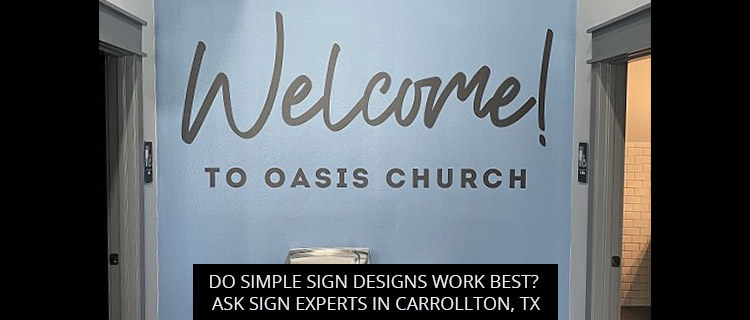Do Simple Sign Designs Work Best? Ask Sign Experts In Carrollton, TX

Keep it short and simple; less is more; simplicity is the ultimate sophistication. We’ve all heard these old adages, each extolling the virtues of simple sign designs, but do they really work best?
It’s time to ask the experts. In today’s post, our sign experts review new research comparing the sales performance of simple and complex sign designs to help you make the best choice for your business.
Read on or call (972)-428-3200 to book a free consultation with our sign experts in Carrollton, Texas.
Ask The Sign Experts: When Should I Keep It Short And Simple (K.I.S.S)?
Historically, marketing managers have favored simplicity in their advertisements, as “less complex stimuli are generally easier to process, resulting in higher fluency” (Knuth et al., 2020, p. 8). Knuth’s review of sign literature also showed evidence that simpler designs enhance the “perceived attractiveness of products and packages,” partly due to the lighter cognitive load they place on the viewer.
But as our sign experts will tell you, the old adage of less is more doesn’t always apply. Sure, simple signs are easier to read, but what if your audience wants more information? And what if they need more information before they understand the value propositions on offer?
Before you default to simple designs for every part of your sign system, understand that simple designs are “easiest to use but lower in functionality” (Knuth et al., 2020, p. 8). Put another way, the simpler your sign (e.g. the fewer words and visual elements it contains), the less information it will contain.
Not all signs need a lot of information to get the job done—simple wayfinding signs (e.g. arrows or one-word room identification signs), basic promos and point of sale displays (e.g. “2 for 1”), and safety signs (e.g. AUTHORIZED PERSONNEL ONLY) come to mind—but some do.
For some examples of when to use complex designs, read on, or call (972)-428-3200 to request a free consultation with a sign expert in Carrollton, TX.
Ask The Sign Experts: When Should I Use Complex Designs?
Complex designs require more cognitive effort to process, but that’s not always a bad thing, science says.
Last year, researchers at the Interdisciplinary Journal of Signage and Wayfinding compared the performances of complex and simple sign designs, and here’s what they found:
- Complex signs get noticed—Reviewing data from Tobii X1 Light Eye Tracker Software, researchers Knuth et al. (2020) determined that complex designs receive more visual attention, scoring higher in fixation intensity and duration compared to simpler signs.
- Complex signs are attractive—In post-experimental interview responses, participants rated complex sign designs as more attractive than simpler alternatives.
So when should you use complex designs? Here’s what the sign experts have to say:
“For unpackaged or minimally packaged goods (e.g. plants, apparel, produce), signs can facilitate the buying decision by providing product information that may not be readily discernible by simply viewing the product,” writes Melinda Knuth, doctoral student and research lead at Texas A&M University. In other words, if there’s not enough information on the packaging, you should include it on your signage.
You might also want to use complex designs if you’re introducing a disruptive new product that nobody’s ever seen. For instance, many modern grocery stores now sell plant-based meat products designed to fry, bleed, taste, and smell like real beef. If you’ve seen these products in-store, it’s probably been in a sign-rich environment, with plenty of information about its health and environmental benefits on display. In contrast, most of the signs you see for traditional ground beef are very simple, since marketers know that consumers know enough about these products to make up their own minds.
Book A Free Consultation With Sign Experts In Carrollton, Texas
To speak with a sign expert in Carrollton straight away, call (972)-428-3200 or request a consultation via the SignCraft and Graphics website.
Back
